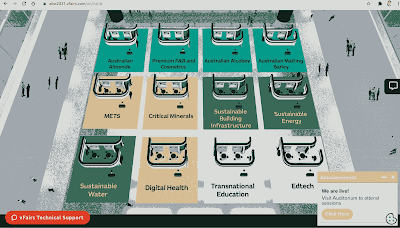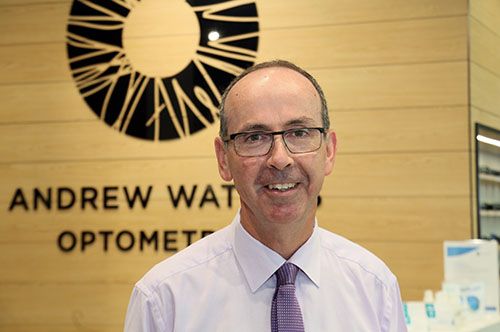While AIBX was using Zoom, I experienced some difficulties with how it was implemented. Normally I would click on a link, or enter a Zoom address, and the Zoom App would start. In this case instead Zoom started in the web browser. This is much slower, to the point of being unusable on my computer. So I had to read the room number from this Zoom session and enter it in the desktop Zoom application. At one point other messages covered the number, so I had to ask the help desk for the Zoom link (they responded quickly).
Thursday, September 30, 2021
Possibilities for Australia/India Education Partnerships
Wednesday, September 29, 2021
Australia India Education Trade Show Online with International Education EdTech Vendors
- Australian TNE in India - Presentation
- Deakin University - Brochure
- Flinders University - Presentation
- Flinders University - Flyer
- University of Southern Queensland - Flyer
- Vetassess - Flyer
- Mission Delegate Profiles
- La Trobe University International Course Guide
- Didasko Institute - Flyer
- Didasko Institute - Presentation
- Typsy - Flyer
- Typsy - Brochure
- Mission Delegate Profiles
Tuesday, September 28, 2021
Australia India Business eXchange 2021
The main interface looks a lot like Second Life,or Mozilla Hubs, which is not necessarily a good thing. The physical meeting venue does not necessarily make for a good online interface, and might just slow things down. A more intimidate problem is that the interface is only available when live sessions are on. This makes no sense and differs from other online trade shows, where you can look at the program, browse virtual trade booths, and leave messages to arrange meetings, at any time.
Sunday, September 26, 2021
Stop Glasses Reflecting Screen During Video Conference
1. Polarizing Filter
An LCD screen uses polarized light to produce images. So a polarized filter over the web camera can block reflections from the screen. The clip-on lens kit I purchased has a polarizing filter, but this was not designed to be used in conjunction with the zoom lens. So I unscrewed the ring holding the polarizing filter in place and inserted it in under the zoom lens. This greatly reduces reflections. Those using DSLR cameras as web cameras will be able to purchase polarizing filters for these.
2. Custom Spectacles
3. Dark Theme
In addition, I have found that a dark theme on the computer desktop helps. This has a black background with white text, so the screen emits much less light. How this is set varies between operating systems, and browsers.
Zoom will go to dark theme, when this is set in the Microsoft Windows, or Apple OS operating systems. However, this doesn't happen with Linux (which I use), or with Android. I have suggested Zoom fix this. It could be rectified by having Zoom follow the operating system theme, or if that is not possible, add a manual setting. Or, Zoom could simply decide to make a dark theme the default for the Android and Linux versions.
An Introduction to Ludic Pedagogy, Webinar, October 20
Sharon Lauricella and Keith Edmunds will present "An Introduction to Ludic Pedagogy", online October 20, 5 pm Edmonton time. I had not heard of Ludic Pedagogy before, but apparently it is about students having fun while still learning in a rigorous way. This is part of Manisha Khetarpal's excellent Microlearning Series at Maskwacis Cultural College in Canada (I gave some talks in the series).
Sharon Lauricella
The idea of fun in education is something I have difficulty with. For me studying and teaching is highly stressful. As a result I find attempts at fun or play even more stressful. However, I have been a participant is ome successful, tightly run exercises, such as Dr Stephen Danns' sessions of Lego Serious Play for ANU staff and students.
Last week I took part in Johnnie Moore and Matt Moore's You Say You Want A Revolution: An Absurdist Encounter Group. But it was more perplexing than enlightening.
Thursday, September 23, 2021
UNESCO Failure to Come Up With a Workable Definition for a Microcredential
The UNESCO report proposes a micro-credential:
"1. is a record of focused learning achievement verifying what the learner knows, understands or can do;
2. includes assessment based on clearly defined standards and is awarded by a trusted provider;
3. has stand-alone value and may also contribute to or complement other micro-credentials or macro-credentials, including through recognition of prior learning; and
4. meets the standards required by relevant quality assurance."
However, every credential should have these characteristics. UNESCO seemed to have missed the hint in the name micro-credential. These are much smaller, but not necessarily literally one millionth, of a conventional qualification. I have, not entirely seriously, suggested these be called Deci or Centi-credentials, as in practice they tend to be one tenth to one hundredth of a three year degree.
Friday, September 17, 2021
Survey Volunteers Needed for Study of Digital Communication and Work Stress in Universities:
 |
| E-stress Survey Link |
This is an excellent initiative, however, they are focusing on those who have a full time working week. Much of the university workforce is part time and casual. These people have been exploited by universities through systematic wage theft, and threatened with loss of work. So I suggest excluding them from studies of work stress will skew the results.
Tuesday, September 14, 2021
An Encounter with the Absurd on Zoom
Greetings from You Say You Want A Revolution: An Absurdist Encounter Group. Johnnie Moore and Matt Moore are using absurdist techniques to help us broaden our thinking about how to achieve our aims. At least that is what I think it is about. This event is sponsored by UTS Information Innovation.
I had forgotten about signing up for this event. But it turned out to be a refreshing counterpoint to the recent very serious video events I have been in. I did help ferment revolution in a pub & parliament. ;-)
Saturday, September 11, 2021
Highest Demand for Digital Technical Skills
Reference
Demand & Impacts on Tech & Digital Skills, An ACS Technical White Paper, The Australian Computer Society, August 2021. URL https://www.acs.org.au/insightsandpublications/reports-publications/demand-impacts-tech-digital-skills.html
Thursday, September 2, 2021
Acoustic Pinboard as Green Screen
Low Cost Home Office Webinar Setup
I use a low cost laptop ($500) plugged into a 24 inch monitor (second hand $100). Internet access is provided by a 4G wireless modem ($50 plus $15 a month for access), plugged into a router configured to limit bandwidth ($100).
Behind the monitor is a web-camera (under $100) with a clip on telephoto lens (under $20). The camera is on a telescopic tripod, so I can push it down out of sight behind the monitor, when not in use (and so it can't see me). I appear in front of a folding green screen (second hand $10, plus $5 for green paint). There is a sound absorbing pin-board behind the monitor, which can also b used as a green screen ($30).
Under the desk is an Uninterruptible Power Supply (UPS) , in case mains power is lost (UPS $10 secondhand, new battery $50).
Beside the monitor is a ring light for better illumination ($10) and my smartphone ($500). I dial-in to the video conference to provide a more reliable audio channel, and as a backup in case the power, laptop or primary Internet connection fails. Also I can monitor how well the audio and video is received using the phone.
I have an ergonomic chair to provide comfort (free second hand). The blood-pressure monitor is just to remind me how stressful online learning can be. ;-)
For a more advanced setup, see Nicolo Malagutti's "A bespoke audio-visual set-up" (2021).
Wednesday, September 1, 2021
Silly Experience Swinburne Online TV Advertisment
Swinburne University wins the Higher Education Whisperer award for the silliest TV ad, for the third successive year with "Experience Swinburne Online". Last year it was online learning like a Zoomba class, this year it is students from other unis doing an interactive learning taste test (like the Pepsi Challenge). The ad doesn't quite work, with the pixeliated faces looking more like criminals than students. Of course prisoners have always been clients for distance education, but I don't think that is what Swinburne has in mind here.
Swinburne University must be feeling a little aggrieved. They have been providing online education for more than a decade, along with Australia's other teaching orientated universities. But with the COVID-19 pandemic, every university is suddenly offering online education. So Swinburne is trying to point out it is doing this better. That may well be the case, but this may not be an effective marketing strategy.
The research orientated universities discovered long ago that students don't select a university based on the quality of the education. They select a university based on reputation, which is mostly about research prestige, and a campus with social activities, neither of which have anything to do with education.
Despite Swinburne's slogan "Not All Online Universities Are The Same", they pretty much are. Swinburne might do better to either adopt the marketing techniques of the major universities, or attack them with humor.
Swinburne could show people in lab coats doing science stuff, and students relaxing in the bar, then briefly mention at the end there is an online option. Or they could show a mock ad for an sandstone university with labs students are turned away from (because they are not PhDs) and sports fields they can't use (because they are not in the elite team), then show Swinburne students happily engaging online.
How to sell a quality online course remains an unsolved problem. Students assume online courses are second best, despite research showing the learning outcomes are just as good. But facts have never been much use for selling anything. A better approach is Holly Hapke's 3-in-1 Hybrid Learning, where the distinction between on and off campus learning is blurred, with students not forced to make a choice in advance. The university can then continue to market a campus, as a symbol, if not a place where actually go very often.





